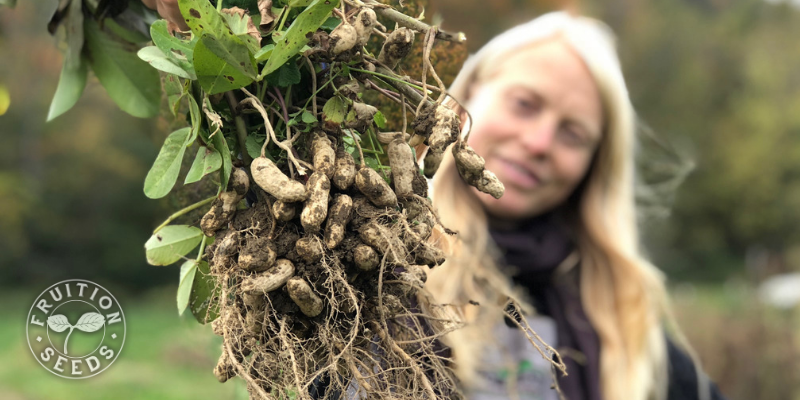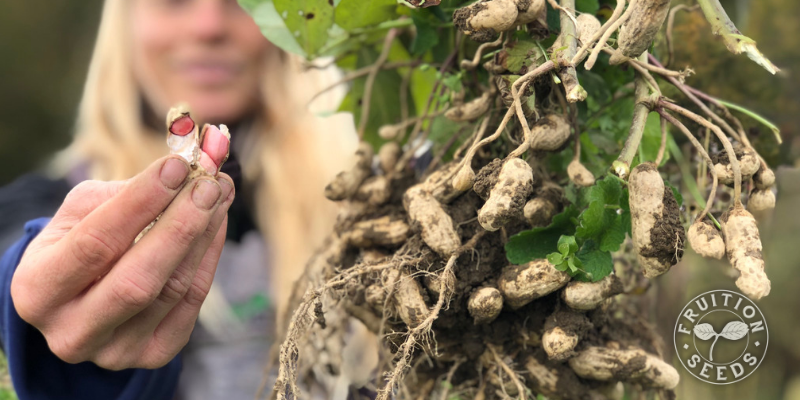I wrote this piece for Edible Finger Lakes’ Notes from the Field column, published November 2019. And if you’re looking for northern-hardy organic peanut seeds, look no further!
My childhood experience of growing peanuts once — and harvesting seven peanuts — convinced me for two decades that growing peanuts in the Finger Lakes was extravagantly futile.
Yet seeds, again and again, remind me that our imagination is the limit, that regional adaptation is the language of resilience, that we can grow so much more than we think possible.
When we started Fruition Seeds in 2012, we were gifted a small bag of Northern Hardy Valencia peanuts from a family on the Upper Peninsula of Michigan who had selected them for over two decades.
Skeptical as I was, they thrived against many odds, including cold, close spacing and a family of groundhogs. We were astonished as we dug our peanuts that fall, finding over 20 gorgeously plump peanuts per plant. In the hottest, driest season on record in our county, we harvested over 40 per plant.
Our Northern Hardy Valencia Peanut harvested in 2016, one of the coldest of seasons on record in our county. We’d love to share seeds with you!
Indeed, in the last seven years we’ve experienced the coldest, hottest, wettest and driest growing seasons on record. Regional adaptation has perhaps never been so critical for our species and the seeds we sow.
And our cultural climate is equally drastic. We rejoice with the stories of young, diverse farmsteads, attend farmers markets and ‘heart’ posts on Instagram, though we cringe a bit as we pay what is less than a living wage for most farmers and choose the convenience of supermarkets’ lower prices for most of our food. ‘When did your family start your farm?’ is a question I’ve been asked hundreds of times, the tip of the status quo’s incredulous iceberg. Matthew, my partner and Fruition’s co-founder, has never been asked this. Once.
Yes, women can start farms. Women can own farms.
These experiences give me greater empathy for people who face all manner of barriers to even greater extents. This understanding inspires me to build a farm, a business, a bioregion and a world that truly celebrates and empowers us all.
Each seed we save and share represents our world transforming, in ways small and not so small, amplifying the beauty and abundance we all may share. Our gardens grow us so much more than we grow them.
And of course, there are the seeds themselves, the resilient and self-replicating genius, the envy of every microprocessor our species will ever manifest. Seeds are the embodiment of the generosity and creativity we need now more than ever, the diversity and tenacity making the monoculture of our minds, so rampant in our fields, finally obsolete.
Plant your peanuts and eat them, too!
Sow Seeds & Sing Songs,

and the Many Beings of Fruition
You Can Grow Peanuts!
For the full story, hop on over to our How to Grow Peanuts in Short Seasons blog.
In the meantime, here’s the quick story to get you started:
If you can grow bush beans, you can grow peanuts! First, find well-adapted peanuts for short seasons. We share ours here! They’re sown at the same time (after final frost, once soil is warm) and similar spacing (six inches between plants). Unlike beans that are harvested in summer, peanuts are harvested after first frost in fall. All summer long they produce darling little orange/yellow flowers which send down purple pegs, or peduncles, to form peanuts underground when they finally reach the soil. Peanuts continue to mature more and more peduncles and peanuts until the first frost finally freezes the leaves. To harvest, loosen the soil in a foot radius around your peanuts with a digging fork and pull the peanut up gently, shaking excess soil back to the ground. We enjoy them roasted as well as boiled, savoring them in all seasons.


